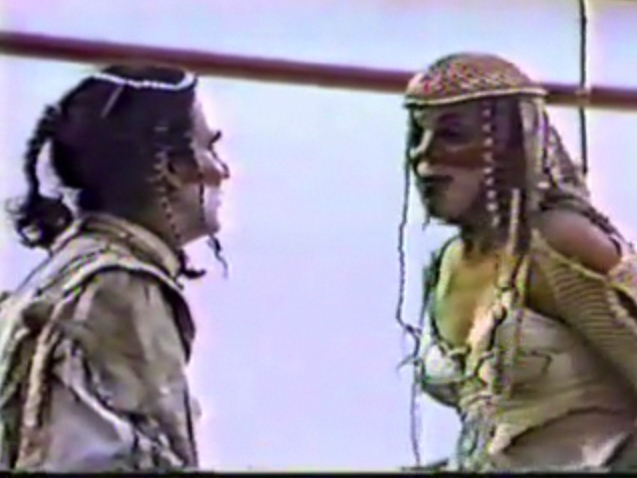About This Clip
Romeu e Julieta
Grupo Galpão’s Romeu e Julieta (1992), directed by Gabriel Villela, is an intercultural adaptation of Shakespeare’s Romeo and Juliet, a production that intentionally draws on a range of popular practices such as street theatre, circus performance and the tradition of the commedia dell’arte, as well as on elements from the cultural imaginary of Minas Gerais in southeast Brazil. The group has done extensive reworking of Onestaldo de Pennafort’s Portuguese translation, cutting a lot of text and transmuting extensive passages into songs and rhythms of the Brazilian backlands. They cunningly mix comedy and tragedy, remediate Elizabethan stage convention and recreate formal and stylistic aspects of Shakespeare’s play. Besides blending Shakespeare’s verse with the syntax of Guimarães Rosa, constantly negotiating between the global and the local, the company appropriated Peter Brook’s conception of Romeo and Juliet as the tragedy of precipitation, which provided them with the idea of acting on stilts to enhance the necessary bodily vertigo for speech and action. The dramatic design and fusion of its hybrid interlocking elements can be pointed out as strategies that contribute to revitalize Shakespeare’s dramaturgy.
Like Shakespeare, who also used recognizable popular songs of his own day, the use popular Brazilian regional songs from Minas Gerais and other regions exerted several important functions, such as marking the beginning and end of some scenes, enhancing the festive atmosphere and reinforcing the intercultural dialogue. In spite of the multiple incarnations of the production in different performance spaces, it is possible to speak of a conceptual unity of the play. By the time it reached the Globe in London, in 2000, the main elements remained constant, while others were introduced when particular circumstances required them. The Globe staging stunningly achieved the same festive effect reached in street theatre.
Production: Grupo Galpão
Conception and Direction: Gabriel Villela
Dramaturgy and texts: Cacá Brandão
Translation: Onestaldo de Pennaforte
Assistant Director: Arildo de Barros
Aerobics: Júnia Portilho
Fencing: Máqui
Costumes: Luciana Buarque
Musical Minuets: Paula Martins
Setting: Gabriel Villela
Puppets: Aguinaldo Pinho
Scores and Musical Preparation: Fernando Muzzi
Vocal Training: Babaya
Lighting: Alexandre Galvão, Wladimir Medeiros
Props: Gabriel Villela , Luciana Buarque e Galpão
Cast: Antonio Edson, Beto Franco, Chico Pelúcio, Helvécio Isabel, Eduardo Moreira, Inês Peixoto, Simone Ordones, Júlio Maciel, Lydia Del Picchia, Rodolfo Vaz, Teuda Bara, Wanda Fernandes, Fernanda Vianna.
Articles
CAMATI, A. S. Brazilian Outdoor Shakespeares: Street Theatre as Public Art. Lapis Lazuli: An International Literary Journal. Commemorating 400 years of Shakespeare, v. 6, n. 1-2, p. 26-33, Spring /Autumn, 2016. <http://pintersociety.com/wp-content/uploads/2016/11/Camati-Anna-Stegh-4.pdf>
Production notes provided by Anna Stegh Camati
Watch the production from 2000 performed at the Globe
Romeu e Julieta
Clips
Related Productions
- Locos X Romeo y Julieta (Conejero, Manuel Ángel; 2012)
- Romeu & Julieta (Romeo & Juliet: An excellent and lamentable dessert) (Teatro Praga; 2017)
- Romeu e Julieta (Romeo and Juliet) (Vogue, Mauricio; 2009)
- Romeu e Julieta – Shakespeare para todos (Romeo and Juliet – Shakespeare For All) (Cabral, Márcio; 2015)
- Romeu e Julieta: Ontem Verona, Hoje Vidigal (Yesterday Verona, Today Vidigal) – (2009) (Fraga, Gutti (Guti); 2009)







Guns, swords, and stilts – a non-sensical version of R&J, but perhaps, the stage cum circus is befitting of the play’s teenage other-worldliness.
Now there is a twin production of Galpao’s production. It is called: Sua Incelenca Ricardo III and of course it deals with Richard III, to be presented at a festival in Russia in 2012.
This teaser seems to reflect the Brazilian adaptation of Shakespearean plays almost as a festival or celebration of some sort. No surprise there, especially with Brazil, holding internationally known holidays like “Carnival”. The use of color and masks is very interesting since as a Latino, South American region, bright colors and the display of passion are elements used often in their works of art.
This is such a dynamic performance. I find myself focusing on the actions themselves…understanding the words doesn’t seem as important in order to follow along and that is very freeing.